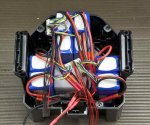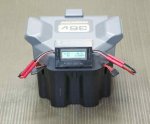I really should have started a new thread for this. :smile:
Anywho, the proposed replacement batteries are eight of these. HobbyKing R/C Hobby Store : Turnigy 5000mAh 5S 20C Lipo Pack .
These would be used in a 10s4p (ten in series, 4 in parallel) arrangement to provide a maximum of 20Ah of capacity at nominally 38V. There is a derating with these also. To maximize cycle life, they will only be charged to 90% of capacity (90% SOC) and will have at least 10% left (90% DOD) giving this a nominal capacity of 16Ah.
This capacity is further derated by discharge rate but in this case, the discharge rate is so low relative to the current these batteries can comfortably deliver (easiliy > 100A!) that this is irrelevant. But let's say the capacity is only 14Ah to be conservative. This is much better than twice the 4-6Ah of the OEM battery - and with a savings of more than 10 pounds (5kg)!
Anywho, the proposed replacement batteries are eight of these. HobbyKing R/C Hobby Store : Turnigy 5000mAh 5S 20C Lipo Pack .
These would be used in a 10s4p (ten in series, 4 in parallel) arrangement to provide a maximum of 20Ah of capacity at nominally 38V. There is a derating with these also. To maximize cycle life, they will only be charged to 90% of capacity (90% SOC) and will have at least 10% left (90% DOD) giving this a nominal capacity of 16Ah.
This capacity is further derated by discharge rate but in this case, the discharge rate is so low relative to the current these batteries can comfortably deliver (easiliy > 100A!) that this is irrelevant. But let's say the capacity is only 14Ah to be conservative. This is much better than twice the 4-6Ah of the OEM battery - and with a savings of more than 10 pounds (5kg)!



